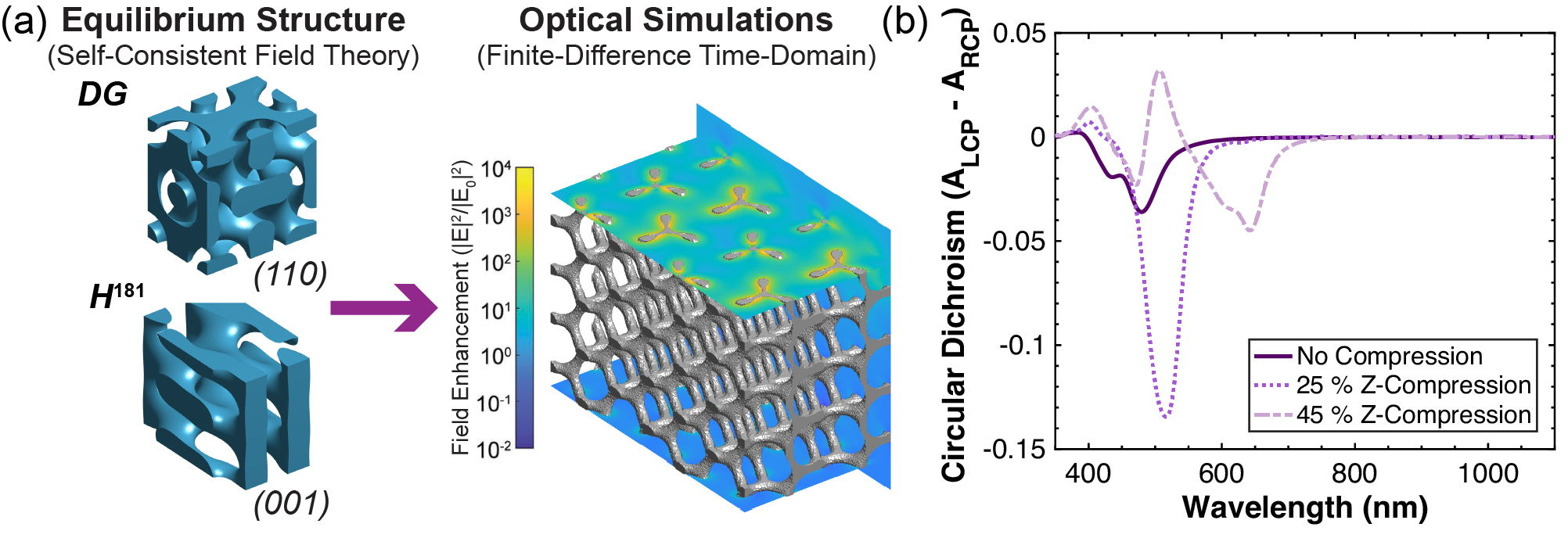Optical metamaterials, whose properties depend not only on material selection but also the spatial arrangement of the material, provide access to interactions with light that are not present in bulk materials alone. Optical metamaterials with responses in the visible and near-IR require nanoscale structural engineering. Block copolymer self-assembly is a scalable method for creating 3D spatially periodic nanoscale structures to act as metamaterial templates. The engineering of polymer structures from the basic diblock copolymer to complex bottlebrushes offers a range of network structures with the requisite nanoscale features. The gyroid morphology, whose curved, percolating structure is composed of triply connected struts, possesses chiral elements such as helices in bulk as well as chiral structures at its surface (depending on orientation and termination). As a result, gyroids are chiral 3D optical metamaterials that exhibit circular dichroism (CD, the differential absorption of left and right circularly polarized light). The strong CD response of gyroids offers significant applications in anti-counterfeit as well as molecular and protein sensing. While many optical simulations of gyroids assume a perfect cubic structure, most applications utilize thin films whose processing often results in distortions, for example compression normal to the substrate or surface rearrangements due to interactions with interfaces. Distorted gyroids as well as the growing library of additional network structures are increasingly challenging to model from a purely mathematical basis and require better basis in physical reality. Combining the output of polymer self-consistent field theory (SCFT) with finite-difference time-domain (FDTD) optical simulations provides thermodynamically equilibrated structures of both distorted gyroids and expanded network geometries (
Figure 1a). This presentation will include a brief overview of the methodology alongside example cases investigating the circular dichroism of compressed double gyroid thin films (presenting results from both SCFT and mathematically derived structures) and the CD of newly hypothesized network structures such as
H181. In the first example, compression normal to the substrate of (110) oriented silver double gyroid thin films results in tunable long wavelength responses (shifts of up to 445 nm) for certain surface terminations. Additionally, a switching behavior from left to right circularly polarized light preferential absorption is observed offering the potential for dynamic systems (
Figure 1b). These responses are found to depend both on the surface and sub-surface structures of the compressed double gyroids. In the second example, the newly computationally discovered
H181 structure when templated with a 0.45 volume fraction of silver in thin film form supports significant CD as a function of both orientation and surface termination with a g-factor (CD normalized to average absorption) of 0.11. Overall, this work creates a pathway for simulating the optical properties of increasingly complex block copolymer based network structures. Additionally, insight from these simulations improves understanding of how the different structural components contribute to circular dichroism.
Figure 1. (a) Illustration of computational workflow for utilizing equilibrium structures from polymer self-consistent field theory, such as the double gyroid (DG) and H181, to finite-difference time-domain simulations. (b) Circular dichroism spectra of (110) oriented silver double gyroid thin films (0.52 volume fraction) without compression (solid) and compressed 25 (dotted) and 45 % (dashed) in the direction normal to the substrate with volume conserved.


